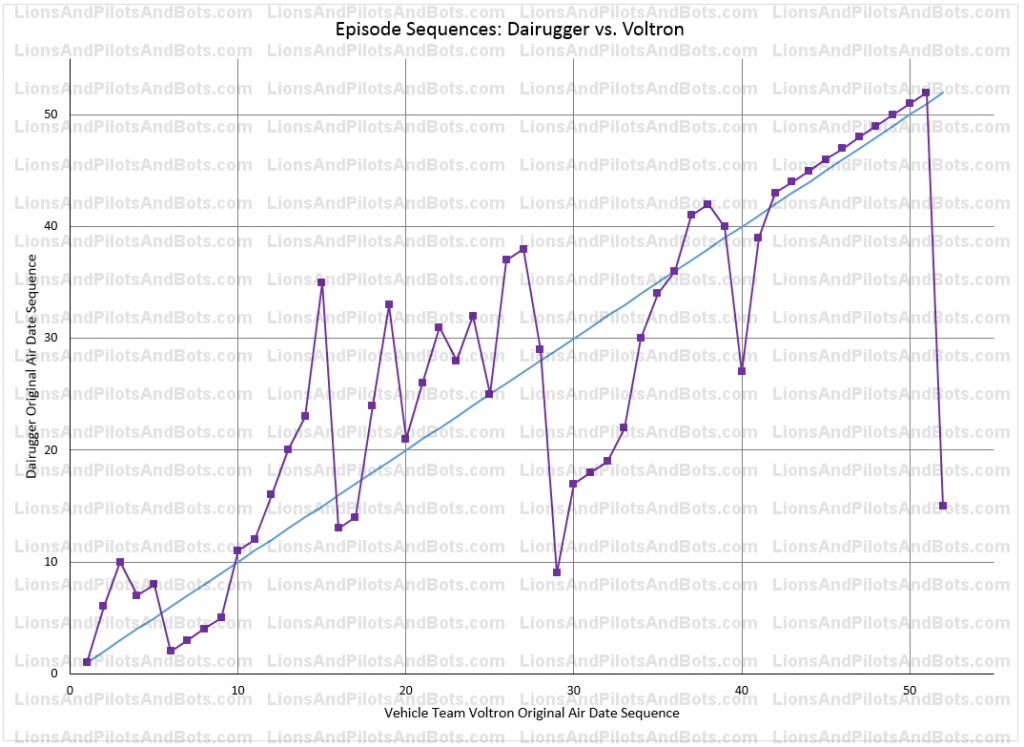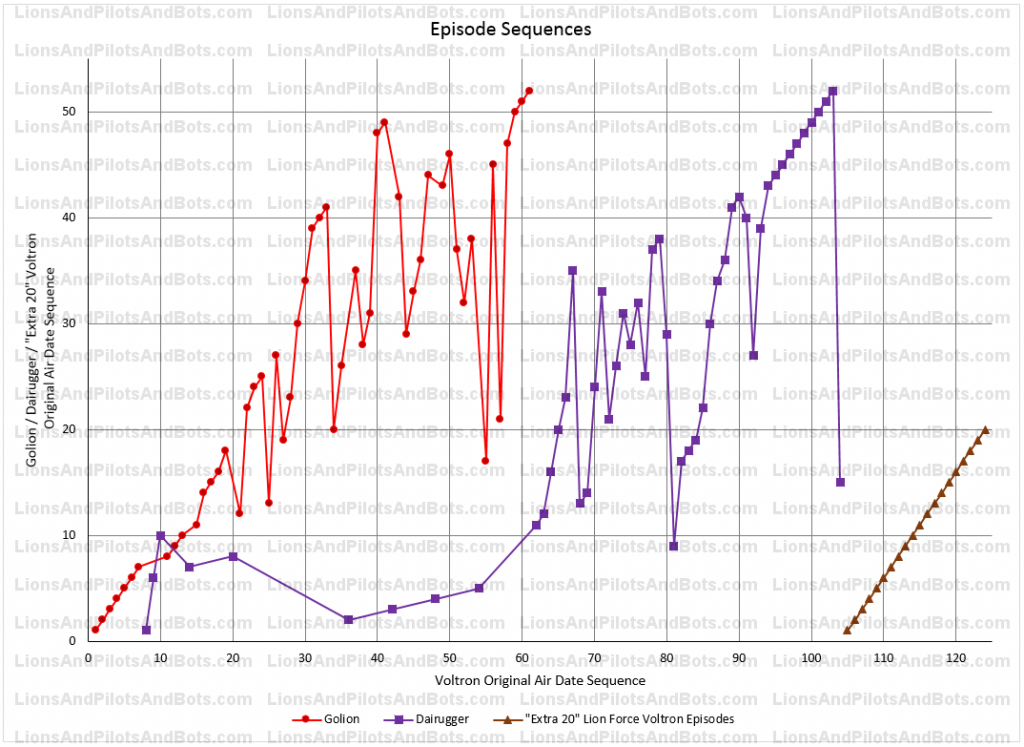When I first watched Voltron: Defender of the Universe in weekday syndication between 1984 and 1986, I had no idea that the show had been adapted from the anime programs Beast King Golion and Armored Fleet Dairugger XV. I first learned this in the late 1980s, in an issue of Starlog magazine, in an article about what was then called “Japanimation.”
When Media Blasters released the Voltron: Defender of the Universe DVD box sets, I noticed something as I thumbed through the episode synopses that had been packaged in the box sets: the episode numbers and the original air dates often seemed… off. For example, Lion Force episode eight, “The Stolen Lion,” originally aired eight days after episode seven, “The Lion Has New Claws.” This seemed odd, since the program ran in weekday syndication. Barring reruns, I would expect two consecutive episodes to air no more than three days apart — the earlier episode airing on a Friday, and the later episode airing on the following Monday.
But things got even weirder. Lion Force episode 14, “Yurak Gets His Pink Slip,” originally aired ten days before episode 13, “The Witch Gets a Facelift.”
As a Star Trek fan, I knew that many episodes of the 1960s television series had originally aired out of production sequence. The first episode to air, “The Man Trap,” was the eighth episode to have been produced. Still, with Voltron: Defender of the Universe having been adapted from two already produced programs, it seemed strange that its episodes would have been adapted out of sequence.
It turns out that the episode numbers in the Voltron DVD box sets correspond to the original air date sequences of the original anime programs. Episodes 1-52 correspond to episodes 1-52, respectively, of Beast King Golion. Episodes 73-124 correspond to episodes 1-52, respectively, of Armored Fleet Dairugger XV. (Episodes 53-72 are the 20 Lion Force episodes that had been animated specifically for Voltron. The “Fleet of Doom” feature episode was sold as a separate DVD.)
For this article, I decided to see just how out of order Voltron: Defender of the Universe is with respect to Beast King Golion and Armored Fleet Dairugger XV.
Here is a comparison of the original air date sequence of all 52 Golion episodes with the original air date sequence of the first 52 Lion Force Voltron episodes.
As you can see…
- The first eleven Lion Force Voltron episodes originally aired in the same order as the corresponding Golion episodes.
- The last three Lion Force Voltron episodes originally aired in the same order as the corresponding Golion episodes.
- The episodes between the first eleven and the last three are a jumbled mess!
Here is a comparison of the original air date sequence of all 52 Dairugger episodes with the original air date sequence of all 52 Vehicle Team Voltron episodes.
From this graph, we can see that…
- Even the first several Vehicle Team Voltron episodes are out of sequence with respect to Dairugger.
- The only long stretch of Dairugger-sequenced Vehicle Team Voltron episodes are episodes 42-51, which correspond to Dairugger episodes 43-52, respectively.
- The final Vehicle Team Voltron episode was the 15th episode of Dairugger!
Even this isn’t the whole story of how out of order Voltron was compared to the original anime programs. Let’s put all of the data together, but first, let’s keep in mind that:
- The first 52 Lion Force episodes of Voltron: Defender of the Universe are considered the program’s “first season.”
- The 52 Vehicle Team episodes are considered the “second season.”
- The “extra 20” Lion Force episodes — that is, the episodes that were animated specifically for Voltron — are considered the “third season.”
- “Fleet of Doom,” the feature-length, animated-for-Voltron episode that often aired in two parts, is generally considered an “extra” episode. (It is not shown in the chart below.)
The first several Vehicle Team episodes originally aired scattered throughout the first 52 Lion Force episodes! It’s likely that these Vehicle Team episodes were repeated again at the beginning of the long stretch of Vehicle Team episodes. There’s a large enough time gap after the first 52 Lion Force episodes for this to have occurred. Still, this is kind of strange.
So what happened? Here is my guess:
- The first several Voltron episodes to be produced were Vehicle Team episodes. This is only speculation, but the pilot episode screened at the NAB conference in February 1984 featured Vehicle Team Voltron (then called Voltron I), and much of the early Voltron marketing materials featured only Vehicle Team Voltron.
- Sometime before Voltron debuted on television in September 1984, someone at World Events Productions decided that the Lion Force episodes adapted from Golion were better than the Vehicle Team episodes. A decision was made to air the Lion Force episodes first.
- After several Vehicle Team episodes of Voltron had been produced, the show makers transitioned into producing all 52 Lion Force episodes adapted from Golion.
- When Voltron premiered in September 1984, Lion Force episodes were broadcast.
- Unable to produce Lion Force episodes quickly enough to keep up with weekday airings, occasional, already completed Vehicle Team episodes were broadcast from time to time.
- After production of all 52 Lion Force episodes adapted from Golion had been completed, the remaining Vehicle Team episodes were produced.
- The Vehicle Team “batch” of episodes aired first with reruns of the already aired Vehicle Team episodes, followed by the ones that had not yet aired.
- After production of all 52 Vehicle Team episodes had been completed, 20 all-new Lion Force episodes, plus the “Fleet of Doom” special, were produced.
- After all of the Vehicle Team episodes had aired, the all-new Lion Force episodes, plus “Fleet of Doom,” were broadcast.
As for why the Voltron episodes aired out of sequence relative to Golion and Dairugger, I suspect the writers did not recognize the serialized nature of the anime programs. This is understandable, given the frantic pace of production, coupled with the anime episodes being in Japanese and lacking English subtitles. In addition, the Voltron episodes might not have been aired in the order in which they had been written or completed. Since the show’s original head writer, Jameson Brewer, died in 2003, we will likely never know for certain.
What are the take-aways from all this? First, it takes a lot of time to produce an animated television series — even one for which the animation was pre-produced. Second, creative and logistical decisions are made at all points in the production process. Third, the popularity of Voltron in the 1980s, and even today, is a testament to the dedication and ability of everyone who worked on Voltron, Golion, and Dairugger. Finally, it took a bit of work to be a Voltron fan in the 1980s, but I already wrote about that, didn’t I?



